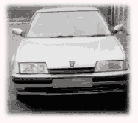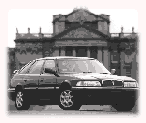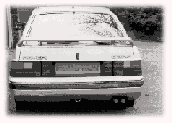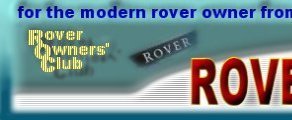 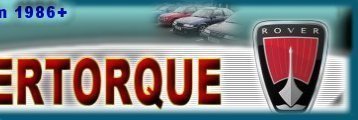 |
| 800 |
. History of the Rover 800 . |
800 |
The Rover 800 was designed in conjunction with Honda Motor Company of Japan, they sold their version of the vehicle under the 'Legend' name tag. The 800 series was launched within the UK in July 1986.
Both Rover & Honda had been looking at the lucrative USA market when developing the car. The Rover 800 would be known as the Sterling in the American market. Unfortunately, the prestigious looking Rover 800 never managed to achieve the same status as BMW's.
Previously, Rover had thought of re-skinning the 10 yr old SD1 model. However, after the success of the Triumph Acclaim, (the badge engineered Honda), (See Rover 200 History & Buyer Guide), the time was now ripe for Honda & Rover to 'talk serious' about building a joint executive car. Staff at Rover, formerly demoralised by the 'badge engineering' exercises, were more than surprised to learn that the designing & building of the new vehicle wouldn't just be a case of Honda showing Rover how to build cars. But more of an exchange & respect for each others capacities & capabilities. The fairly 'narrow' width of such an up market vehicle (less than 2 Metres) stems from Japans' curious taxation class regulations, meaning that the Legend also affected the Rover 800. The vehicles consist of a large, one piece floor pan which is torsionally braced hence the 'prop shaft tunnel' bulge running down the floor.
Rover were still known as The Austin Rover Group (ARG) when the 800 was first launched. The car had started life known as Project: XX in it's development days. Although most early models were on 'D' plates, some test models were registered on a 'C' plate. Replacing the aging Rover SD1, the 800 was initially only available in 4 door saloon version. It was not until mid-1988 that the '5 door' Fastback was introduced. Early models were supplied with the 2.0 litre 'O' series engine only, which dated back to the Montego/Maestro era+, but with twin overhead cam & all new cylinder head & valve train. These engines were 4 cylinder, in line, with an alloy head & cast iron block. Anyone with experience of the 2.0 Litre engine will be well aware of the regular oil leak which develops at the front.
The 'executive' engine option at this time was the very reliable Honda 2.5 litre V6.
The 2.0 litre engines were available with single point fuel injection, typically giving 119 bhp @ 5600 rpm, a top speed of 119 mph, 0-60 in 10 sec and 24.7 mpg, or multi-point fuel injection, giving 131bhp @ 6599 rpm, top speed of 127.9 mph, 0-60 in 9.8 sec and a fuel consumption of 27.6 mpg, depending upon specification of car purchased.
All engines were transverse mounted, driving the front wheels through either a 5 speed manual or 4 speed automatic(825)/4 speed sports automatic(827) gearbox. Even though the 800 is such a large vehicle, the 2.0 litre engine normally seems quite happy & 'perky' to pull the body weight around, providing you don't want stunning brands hatch performance. Earlier variations of the 800 were basically the same vehicle under different model names. It was not until some time later that the Vitesse had it's suspension 'tweaked' in an effort to make the ride suit the cars more sporty looks & name.
A carburettor version became established within the line up. The 820 Fastback had the familiar Montego overhead cam 8 valve engine, offered primarily as a reps' vehicle competing with the likes of BMW, Vauxhall & Ford etc. these cars tended to be the 'basic' of the range giving 100bhp @ 5400 rpm, 0-60 in 11.6 sec, a top speed of 113 mph & a fuel consumption of 24.4 mpg. If you are looking for extras, go for a higher specification vehicle. The UK Sterling came with everything as standard. For the racer's amongst you, Turbo Charged 2.0 litre 800's were available.
Minor styling revisions through the years, culminated in a major facelift in 1992 (Introducing the Rover 800 MK11). Also, later that year found the introduction of the stunningly beautiful 800 Coupe. It was also in 1992 that the 2.0 litre 'O' series engine was finally retired in favour of the 'T' series engine, similar to the 'O' series but with significant revisions in many areas. 1994 saw air bags being fitted to some of the range & becoming standard by 1996.
825/827 & Sterling were powered by a Honda manufactured unit, which was all alloy construction, 24 valve, 6 cylinder in 90º V, dry lined, either a 2.5 litre or 2.7 litre engine (introduced in 1988) both with programmable fuel injection. The engines were very similar, except for the larger capacity of the 2.7 litre block. The engines gave 173 bhp (177 bhp for 827) @ 6000 rpm, 0-60 in 8 sec (8.4) with a max. speed of 129 (131) mph. 1996 saw the all new KV6 engine replace the 2.7 litre Honda engine, after the sale of Rover to BMW, Honda withdrew the supply of their engines. There are a few unconfirmed reports that the KV6 engine can be problematic, however, generally it is thought of as a good replacement for the Honda unit. The engine has the capability to run as a true V6 or two separate 3 cylinder engines to give improved torque, particularly when towing.
A diesel version (825D) was also available, producing 118 bhp @ 4200 rpm, 0-60 in 10.5 sec, max. speed of 117 mph & around 57.8 mpg @ constant 56 mph.
All cars were fitted with independent suspension at the front via double wishbones & coil springs. Whilst the rear suspension is transverse trailing link & coil springs. Power assisted steering was standard on all models.Standard features included:
Electric FRONT windows, Central locking, Stereo Radio/Cassette.
Optional features included:
A.B.S., Air conditioning, Headlamp washers, Electric rear windows. (Some of the options were fitted as standard on higher spec. vehicles).
Vehicle Dimensions & Weight:
Length = - '92 = 4.69 Metres. Length = +'92 = 4.88 Metres
Width = - '92 = 1.95 Metres. Width = +'92 = 1.97 Metres. Width =Coupe= 1.99 Metres
Height = - '92 = 1.4 Metres. Height = + '92 = 1.36 Metres. Height =Coupe= 1.4 Metres
Turning Circle = 11.9 Metres
Curbside Weight = 1300Kg - 1450Kg depending upon vehicle specification. (1300 Kg=Saloon - 1450Kg=Coupe).
Further Reading:
Transport Source Books
(Rover 800 series 1985-1991) (collection of road tests, articles & adverts of the day).
TSB337/ISBN 85847 337 3
Tel: 01473 724688
Haynes Owners Workshop Manual
(Rover 820, 825 & 827 1986-1995)
Haynes1380/ISBN 1 85960 071 9
There is also a range of tuning parts available covering the suspension & body. Catalogue available from:
Moto-Build Racing.
Tel: 0181-893 4553Here is a list of telephone numbers which may be useful if you are thinking of purchasing a second hand/used Rover.
1/ Used Car Inspection
RAC - 0990 333660 (www.rac.co.uk)
AA - 0345 500610 (www.theaa.co.uk)
2/ Driving Licence
DVLA -0870 240 00093/ Vehicle History
DVLA - 0870 240 0010
Equifax HPI - 01722 422 422 (outstanding finance check etc.)
Rover 800's come in all conditions, rough & ready run about or immaculate & well cared for.
Article compiled by Steve Wright (Copyrightt ©copywrigh 2000+)
| | | |
|
THE
Club for ALL Modern Rover Owners . . . . |
